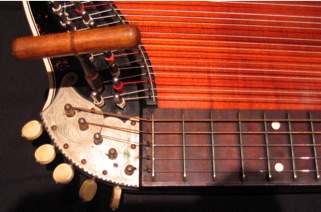How to tune the Concert Zither?
Tuning the Concert Zither
In this video I demonstrate tuning all the strings of a concert zither with a digital tuner(Munich tuning)
The zither gets out of tune very quickly and is sensitive to temperature changes. Tuning can be done with the help of a tuning fork or a piano, but an electronic tuner is the easiest (from about AU$30).
The fret board strings have tuning keys and a machine head similar to a guitar. The open strings are wound around tuning pegs and they are tuned with a key.

The Fret Board Strings
The Fret Board Strings are tuned C, G, D, A, plus one string doubled to make it easier to play chords or 2 or 3 part melodies. Because of different geographical regions different tunings evolved different strings were doubled. Our days two tunings survive:
(See diagram in Links & Downloads for assistance with tuning)
“Vienna Tuning” and “Munich Tuning”
MUNICH TUNING is more widely used. The fret board has two identical A strings, thus: A, A, D, G, C.
VIENNA TUNING has two identical G strings: A, D, G, G, C.
THE ACCOMPANIMENT STRINGS are always arranged with one red string followed by 3 white strings, to assist the eye and the hand to find a starting point.
The strings starting next to the fret board usually have the following order: Eflat, Bflat, F, C ...
Sometimes the first string is: Aflat, then Eflat, Bflat, F, C, etc.
The strings F, A, C sharp should always be red.
The 12 thinner strings are used for playing accompaniment chords with right index and middle finger.
The thicker strings are bass strings and are plucked with the right ring finger(starting with string 13).
Some concert artists have zithers with over 40 strings. They have a set of contra bass strings after the bass strings, tuned chromatically.
If this answer doesn't help try other resources at the Links page, or contact me directly.
Back to Frequently Asked Questions